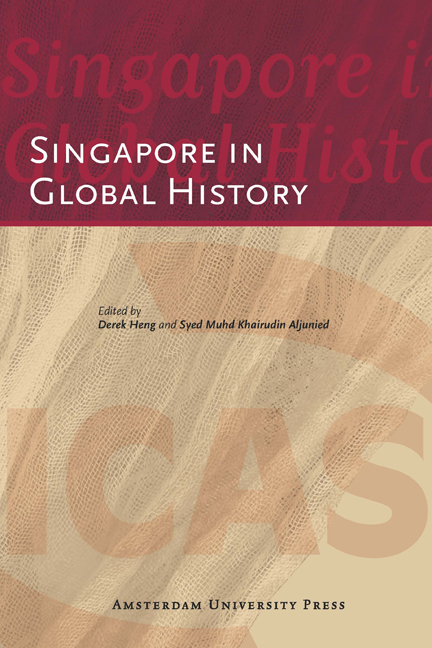Book contents
- Frontmatter
- Contents
- List of Tables and Illustrations
- Foreword
- 1 Globalising the History of Singapore
- 2 Situating Temasik within the Larger Regional Context: Maritime Asia and Malay State Formation in the Pre-Modern Era
- 3 The Singapore River/Port in a Global Context
- 4 ‘Walls of Illusion’: Information Generation in Colonial Singapore and the Reporting of the Mahdi-Rebellion in Sudan, 1887-1890
- 5 The Littoral and the Literary: Making Moral Communities in the Straits Settlements and the Gold Coast in the late Nineteenth and Early Twentieth Century
- 6 Social Discourse and Economic Functions: The Singapore Chinese in Japan’s Southward Expansion between 1914 and 1941
- 7 The Dynamics of Trans-Regional Business and National Politics: The Impact of Events in China on Fujian-Singapore Tea Trading Networks, 1920-1960
- 8 Rambutans in the Picture: Han Wai Toon and the Articulation of Space by the Overseas Chinese in Singapore
- 9 The Global Effects of an Ethnic Riot: Singapore, 1950-1954
- 10 The British Military Withdrawal from Singapore and the Anatomy of a Catalyst
- 11 Bringing the International and Transnational back in: Singapore, Decolonisation, and the Cold War
- 12 The Global and the Regional in Lee Kuan Yew’s Strategic Thought: The Early Cold War Years
- 13 A Brief History of the Hub: Navigating between ‘Global’ and ‘Asian’ in Singapore’s Knowledge Economy Discourse
- About the Contributors
- Bibliography
- Miscellaneous Endmatter
2 - Situating Temasik within the Larger Regional Context: Maritime Asia and Malay State Formation in the Pre-Modern Era
Published online by Cambridge University Press: 02 February 2021
- Frontmatter
- Contents
- List of Tables and Illustrations
- Foreword
- 1 Globalising the History of Singapore
- 2 Situating Temasik within the Larger Regional Context: Maritime Asia and Malay State Formation in the Pre-Modern Era
- 3 The Singapore River/Port in a Global Context
- 4 ‘Walls of Illusion’: Information Generation in Colonial Singapore and the Reporting of the Mahdi-Rebellion in Sudan, 1887-1890
- 5 The Littoral and the Literary: Making Moral Communities in the Straits Settlements and the Gold Coast in the late Nineteenth and Early Twentieth Century
- 6 Social Discourse and Economic Functions: The Singapore Chinese in Japan’s Southward Expansion between 1914 and 1941
- 7 The Dynamics of Trans-Regional Business and National Politics: The Impact of Events in China on Fujian-Singapore Tea Trading Networks, 1920-1960
- 8 Rambutans in the Picture: Han Wai Toon and the Articulation of Space by the Overseas Chinese in Singapore
- 9 The Global Effects of an Ethnic Riot: Singapore, 1950-1954
- 10 The British Military Withdrawal from Singapore and the Anatomy of a Catalyst
- 11 Bringing the International and Transnational back in: Singapore, Decolonisation, and the Cold War
- 12 The Global and the Regional in Lee Kuan Yew’s Strategic Thought: The Early Cold War Years
- 13 A Brief History of the Hub: Navigating between ‘Global’ and ‘Asian’ in Singapore’s Knowledge Economy Discourse
- About the Contributors
- Bibliography
- Miscellaneous Endmatter
Summary
Introduction
Singapore's history as a port settlement has, until very recently, been considered to date from around 1819. The general consensus had been that no significant settlement existed prior to that date. Indeed, the late Raffles Professor of History at the University of Singapore – Wong Lin Ken – once commented that “no historian has yet adequately explained why Singapore failed to be a major trading centre before the nineteenth century” (Wong 1981: 15).
Since the 1980s, however, significant archaeological research, coupled with a reassessment of the historical documents relating to the island's history before the nineteenth century, have led to the conclusion that Singapore did have a history prior to the modern era. This history of the port settlement, which was known as Temasik, dates back to the late thirteenth and fourteenth centuries, after which there was a gap of around four centuries before Singapore was once again rejuvenated as a port city (cf. Heng 1999, 2002; Miksic 1985).
While the historical genesis of Singapore has been successfully extended back into the past by more than five centuries, another issue remains: why did Singapore's history as a pre-modern state only start in the late thirteenth to fourteenth centuries? Archaeological data suggest that there was no settlement prior to the late thirteenth century and that the port settlement declined in the fifteenth century and ceased to exist in the early sixteenth century (Kwa, Heng & Tan 2009: 59 & 61). More recently, research on Portuguese and Spanish textual accounts of the Straits of Singapore indicate that all the important events from the sixteenth to eighteenth centuries took place in the sea around the island, instead of on the island itself (Kwa, Heng & Tan 2009: 63-82; Borschberg 2009). Its founding in the late thirteenth century has therefore been considered by historians to be an anomaly, leaving one to ponder why no port settlement of consequence existed before the fourteenth century or after the early sixteenth century. Wong Lin Ken's comment above is highly relevant here. The general pattern seems to contradict the inherent predisposition to settlement formation, given the island's strategic location at the crossroads of the Bay of Bengal, Java Sea and the South China Sea regions.
- Type
- Chapter
- Information
- Singapore in Global History , pp. 27 - 50Publisher: Amsterdam University PressPrint publication year: 2012



